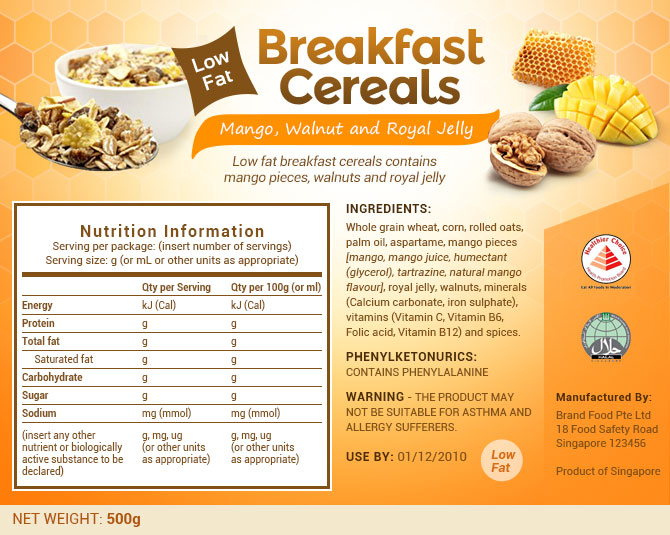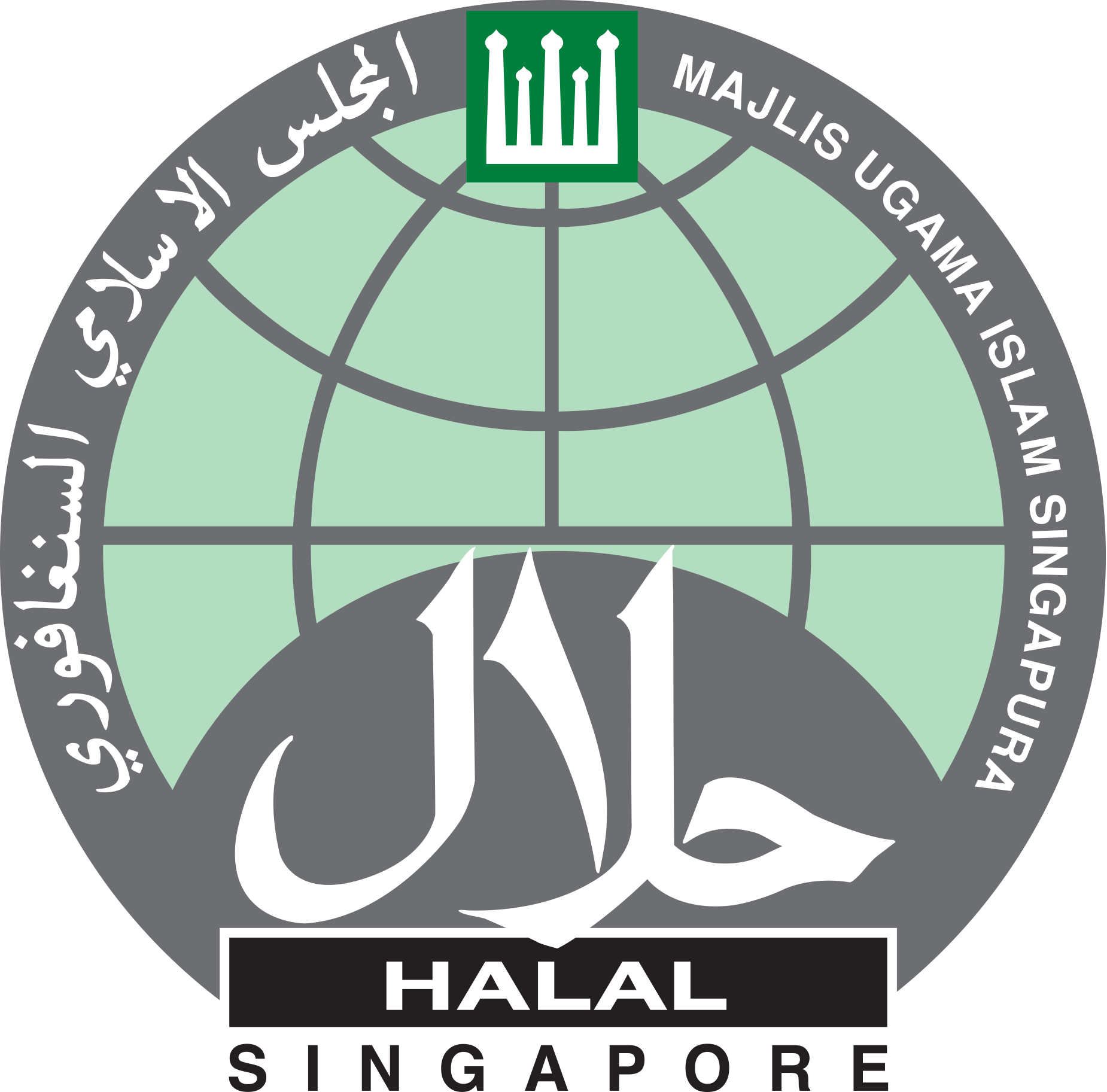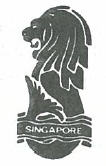Name of the food
Name of the food (mandatory for all prepacked food)
Labels are mandatory for all prepacked food
Whether you are picking up groceries or grabbing a quick ready-to-eat meal, every prepacked food item you buy must come with a label.
Labels ensure food is safe for consumption
Labels can be lifesavers
Labels support dietary needs
Labels increases accountability of food businesses
Labels help ensure food safety
Legibility matters
When it comes to food labels, all mandatory information must be printed in letters no smaller than 1.5 mm in height so that consumers can easily read the information. This means that the lowercase letters of the printed alphabet must be at least 1.5 mm in height.
Decoding food labels
There are many labelling requirements designed to protect consumers. For example, labels must list all ingredients and clearly state the net quantity, so you know exactly what you are consuming. Product claiming to be ‘low-fat’ or ‘high in fibre’ must be backed-up by detailed nutritional information to support these claims.
Click on the different sections to decode the label and know how you can identify vital information that will help you make informed choices!

Statement of Ingredients
Statement of Ingredients (mandatory for all prepacked food)
To protect consumers with food allergies in line with international food labelling standards, the food regulations require the statement of ingredients on labels of prepacked food to clearly indicate the following ingredients known to cause hypersensitivity in individuals:
| No. | Group | Ingredients |
|---|---|---|
| (i) | Cereals containing gluten
| Wheat, rye, barley, oats, spelt, their hybridised strains, and their products. |
(ii) | Crustacean and crustacean products
| Crayfish, prawns, shrimps, lobsters, crabs, and their products. |
| (iii) | Eggs and egg products | Eggs from laying hens, ducks, turkeys, quails, geese, gulls, guinea fowls, and their products. |
| (iv) | Fish and fish products | Marine or freshwater animals, including fish, molluscs (such as oysters, clams, and scallops), and their products. |
| (v) | Peanuts, soybeans and their products | Peanuts, which may be declared using ‘groundnuts’ or similar terms, and soybeans, which may be declared using terms such as ‘soya’ or ‘soy’. |
| (vi) | Milk and milk products (including lactose) | Milk from cows, buffaloes, goats, and their products. |
| (vii) | Tree nuts and nut products | Almonds, hazelnuts, walnuts, cashew nuts, pecan nuts, Brazil nuts, pistachio nuts, macadamia nuts, and their products. |
| (viii) | Sulphites in concentrates of 10mg/kg or more | Sulphites directly added and/or carried over from food ingredients at a total concentration of 10mg/kg or more (calculated in terms of total sulphur dioxide). |
Allergens are sometimes declared on food labels through the use of phrases like ‘contains peanuts’, ‘may contain peanuts’, or ‘made in a facility that processes peanuts’, to caution the possibility that the food product may contain allergenic ingredients. You can approach the food business stated on the label if you require more information.
Net Quantity
Net Quantity (mandatory for all prepacked food)
The labels on prepacked food must clearly show the net quantity to enable consumers to make informed decisions.
For solid food, this is the weight of the food without any packaging. For example, the net weight for milk powder in tins is the weight of just the milk powder and does not include the weight of the tin.
In the case of frozen seafood that has been glazed with ice, the net weight must exclude the weight of the ice glazing.
Net quantity values
| Product | Measurement method | Units of measure |
|---|---|---|
| Liquid foods | By volume
| millilitres (mL) or litres (L) |
Solid foods | By weight | grams (g) or kilograms (kg) |
| Semi-solid or viscous foods (e.g. tomato paste and yoghurt) | By volume or by weight | millilitres (mL) or litres (L); grams (g) or kilograms (kg) |
Declaration of drained weight
When buying solid food packed in a liquid, like canned tuna or vegetables, the label should clearly show both the net weight and the drained weight.
Products that require indication of the drained weight on the label
Products that do not require indication of drained weight
Details of Local Business
Details of Local Business (mandatory for all prepacked food)
Imported Food Products
Labels on imported foods must include the name and address of the local importer, distributor, or agent, as well as the country of origin.
Locally Manufactured Products
For locally made products, the label must show the name and address of the local manufacturer, packer, or vendor.
These details enable traceability and are crucial in the event of food recalls. It also enables consumers to contact the local business directly to give feedback or raise concerns about the product.
Country of Origin
Country of Origin
Labels on imported food must show the country of origin so that consumers know where the food product is imported from.
For food that is produced locally, the food business operator may voluntarily indicate that the food is of local origin.
‘Made in Singapore’ or ‘Product of Singapore’
Food products that have undergone significant manufacturing processes in a licensed food business in Singapore, may qualify to carry the ‘Made in Singapore’ or ‘Product of Singapore’ label.
‘Packed in Singapore’
Imported foods that are simply packed in Singapore must be labelled as ‘Packed in Singapore’, with the label also showing the country of origin, so that consumers are informed of the origin of the product.
Origin of individual ingredients
It is not mandatory for food business operators to disclose the origin of the individual ingredients used in prepacked food, as it may be impractical to do so.
For instance, packaged processed foods often contain ingredients from different countries. It is not feasible to list all their origins.
SFA requires all food sold in Singapore to meet the prevailing safety standards. Hence, you can be assured that the food you buy is safe.
You can contact the food business directly if you require more information about the origin of a specific ingredient in the food product.
Warnings
Warnings
Food labels must include warnings for specific ingredients or allergens. Some examples include:
Aspartame Warning
Food products containing aspartame are required to carry a caution statement: ‘PHENYLKETONURICS: CONTAINS PHENYLALANINE’ to alert consumers about the presence of phenylalanine.
Royal Jelly Warning
The label on royal jelly and foods containing royal jelly must state: ‘WARNING - THIS PRODUCT MAY NOT BE SUITABLE FOR ASTHMA AND ALLERGY SUFFERERS’.
Nutrition Information Panel
Nutrition Information Panel
(With effect from 2 May 2024, this comes under the Ministry of Health and the Health Promotion Board)
The Nutrition Information Panel (NIP) provides you with information on the energy value as well as the amounts of protein, carbohydrates, and fat in the food product.
Details that are mandatory
Labels for products with nutrition claims, such as edible fats/oils as well as special-purpose foods like infant formula, the label must include a NIP with the following details:
- energy, in kcal/kJ
- protein, in grams (g)
- fat, in grams (g)
- carbohydrate, in grams (g)
- nutrients that are part of a nutrition or health claim, in grams (g)
Serving sizes
The declaration of ‘serving size’ and ‘servings per package’ in the NIP is only necessary if the nutrients are listed on a per-serving basis.
The ‘per serving’ column shows the nutrient content in one serving of the food. This information helps you understand how much of each nutrient you will get from a single serving, so that you can manage your daily intake.
Comparing nutritional content
As serving sizes can vary between brands of similar products, it may be better to reflect the nutritional content of food products as ‘per 100g’ or ‘per 100ml’ instead of ‘serving size’.
Nutrition and Health Claims
Nutrition and Health Claims
(With effect from 2 May 2024, this comes under the Ministry of Health and the Health Promotion Board)
All nutrition and health claims on food products must be truthful and verifiable based on scientific evidence.
Nutrition claims are voluntary
A nutrition claim is voluntary and suggests or implies that a food has nutritional value. Examples include claims like ‘High in fibre’, ‘Low in fat’, ‘Cholesterol free’, and ‘Sugar-free’.
Guidelines for nutritional claims
To sell food products with nutritional claims in Singapore, businesses must comply with the guidelines found in the ‘Handbook on Nutrition Labelling’ published by the Health Promotion Board.
For example, products that claim to be ‘low fat’ must contain less than 3g of fat per 100g.
Examples of health claims
A health claim is a claim that states, suggests, or implies that there is a connection between consuming the product and a health benefit.
Here are some examples of health claims:
- Nutrient function claims: These claims describe how a nutrient contributes to your body’s growth, development, or functions. An example is: ‘Calcium helps to build strong bones and teeth’.
- Reduction of disease risk claims: These claim that eating certain foods can lower your chances of developing specific diseases or health conditions as part of a healthy diet. An example is ‘A healthy diet rich in fibre-containing foods such as wholegrains, and fruits and vegetables may reduce the risk of some types of cancers.’
- Other function claims: These describe the health benefits of various food components. An example is: ‘Probiotics help in digestion’.
Use food labels wisely
Claims and nutrition information panels on food labels are great tools for helping you make informed food choices. Here is how you can use them wisely:
- Be mindful that no single food can provide all the nutrients you need or prevent or cure a disease, condition, or allergy.
- Be cautious of exaggerated, over-the-top claims. If a product promises quick health fixes, be wary.
- Always consult your doctor before consuming any food for its health benefits if you have a pre-existing medical condition.
Expiry Dates
Expiry Dates
Labels reflecting ‘Use by’, ‘Expiry date’, ‘Best before’, or ‘Sell by’ are important indications of when the food might start to lose its freshness and quality.
‘Packing date’ for raw meat and fish
Labels for fresh and chilled raw meat and fish will indicate a packing date instead of an expiry date. Do examine their freshness at the store by looking for any bad smells or unusual colours to ensure that the meat or fish remains good for consumption.
Foods that must indicate expiry dates
It is mandatory for certain food products to have expiry dates on the labels. These include:
- perishables or short shelf-life products (e.g. pasteurised milk, dairy products, and chilled food products);
- products whose quality may deteriorate over time (e.g. cooking oil and juice drinks);
- products that are susceptible to contamination when stored for too long (e.g. breakfast cereals and flour can become infested with insects); and
- infant food.
It is the responsibility of the food business operator (manufacturer, packer, or vendor) to ensure the expiry date is clearly stated on such products.
It is mandatory for expiry dates to be stated for the following 19 categories of food.
| S/N | Category of Food |
|---|---|
| 1 | Cream, reduced cream, light cream, whipped cream and sour cream excluding sterilised canned cream. |
| 2 | Cultured milk and cultured milk drink. |
| 3 | Pasteurised milk and pasteurised milk drink. |
| 4 | Yoghurt, low-fat yoghurt, fat-reduced yoghurt, non-fat yoghurt, and yoghurt products. |
| 5 | Pasteurised fruit juice and pasteurised fruit juice drink. |
| 6 | Pasteurised vegetable juice and pasteurised vegetable juice drink. |
| 7 | Tofu, ‘tauhu’ or ‘doufu’, a soya beancurd product made of soya beans, water, and a coagulant, including ‘egg tofu’, ‘taukua’ or ‘dougan’, and the soft soya beancurd desert known as ‘tauhui’, ‘tofa’ or ‘douhua’, but excluding the oil fried tofu in the form of a pouch known as ‘taupok’, and the dried beancurd stick. |
| 8 | Food which is stored or required to be stored at a chilling temperature to maintain or prolong its durable life, including ready-to-eat minimally processed fruits and vegetables such as cut fruits and vegetables but excluding all other forms of raw fruits and vegetables. |
| 9 | Vitaminised fruit juice and vitaminised fruit juice drink. |
| 10 | Vitaminised vegetable juice and vitaminised vegetable juice drink. |
| 11 | Liquid milk and liquid milk products excluding condensed milk, sweetened condensed milk, evaporated milk, and canned sterilised milk and milk products. |
| 12 | Flour |
| 13 | Salad dressing |
| 14 | Mayonnaise |
| 15 | Raisins and sultanas |
| 16 | Chocolate, milk chocolate and chocolate confectionery in which the characteristic ingredient is chocolate or cocoa, with or without the addition of fruits and nuts. |
| 17 | Breakfast cereal with or without fruits and nuts, except cereal in cans. |
| 18 | Infant Food |
| 19 | Edible cooking oils |
Storage instructions
Food products that must be stored under certain conditions to maintain its freshness and remain safe for consumption until the expiry date must have storage instructions indicated on the label.
Example of storage instructions include 'Refrigerate after opening'. 'Keep refrigerated', and 'Consume within 3 days of opening'.
Safety goes beyond expiry
Food can go bad even before the expiry date if it is not stored correctly.The expiry date is no longer valid once you open the food packaging. Always look for signs of spoilage, such as an unusual odour or swollen packaging, before buying and consuming the food product.
Pictorial Illustrations
Pictorial Illustrations
Food businesses can include images or pictures on food labels, but they must truthfully and accurately show what is inside the package.
Labels that use pictures to suggest ways to serve the food must clearly state ‘Recipe’ or ‘Serving Suggestion’ in big enough letters (at least 1.5mm tall). This helps consumers understand that the pictorial illustration is just a suggestion of how you may serve the food and does not reflect what is in the packaging.
Logos and Barcodes
Logos and Barcodes

Halal Logo
The use of the "Halal" logo in Singapore is under the purview of Majlis Ugama Islam Singapore, MUIS. Please visit MUIS for more information on the use of the "Halal" logo on food products.

Healthier Choice Symbol
The Healthier Choice Symbol is administered by the Health Promotion Board (HPB). Please visit the HPB website for information on the application to use this symbol for food products.

The Merlion symbol is an asset owned by the Singapore Tourism Board (STB). You may refer to the STB website
for details on the use of the Merlion logo.

The Lion Head Symbol is managed by the National Heritage Board (NHB). You may refer to the Guidelines on the Use of the Lion Head Symbol on the NHB website.

Products that are labelled with a barcode beginning with ‘888’ are issued by GS1 Singapore. The GS1 barcode numbers with the ‘888’ prefix are only issued in Singapore. However, this does not mean that a product with a barcode prefix of ‘888’ is of Singaporean origin. For more information on barcodes, see the GS1 Singapore website.
This write-up provides a comprehensive explanation of the various elements of food labels. We hope you will feel more confident in making informed choices and can easily navigate food labels on your next shopping trip.
